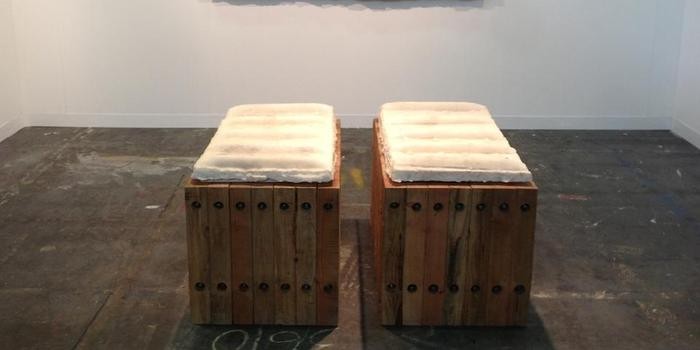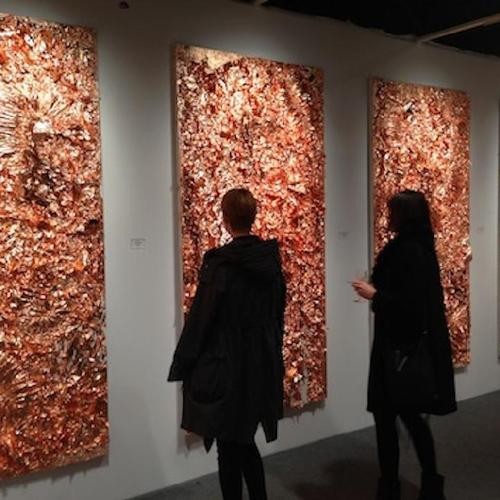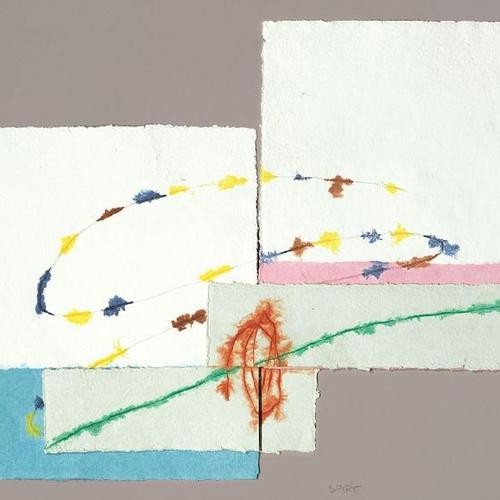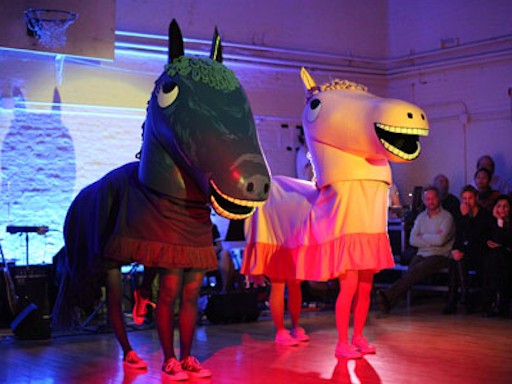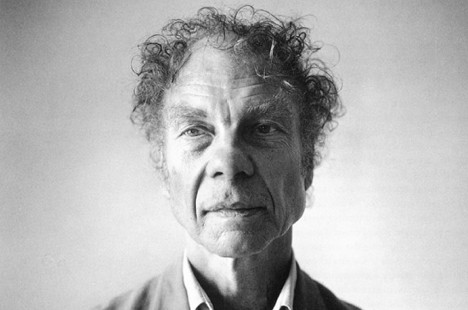With wider aisles and a more thoughtfully curated presentation, this year's Armory Show is a wonderland for the eye—but walking through the aisles and simply taking in the surface pleasures of the work on view beggars one of the rich meanings that lurk behind the objects. To get the art part out of the art, and not just the prices or decor factor, one has to dig deeper into the individual pieces. Here's a roundup of nine works that reward closer inspection.
DAVE COLE'S SALT PRINT (LA SOMME) (2012) AT DODGE GALLERY

The Providence-based artist Dave Cole has a knack for bending the most recalcitrant materials into piercing critiques of American culture—for instance, using aviation-grade steel cables to sew together a lead American flag—and that's certainly the case with this work. Building a kiln outside his studio that could melt salt to a liquid state (which requires more heat than melting any metal), he made a cast of the treads of the oldest tank ever made that was used in the 1916 Battle of the Somme, which Cole sees as the beginning of industrial warfare—as many as a million people died in four months of fighting—and, in turn, the rise of the American military-industrial complex.
DAVE MIKO AND TOM THAYER'S UNTITLED (2011-12) AT ELEVEN RIVINGTON
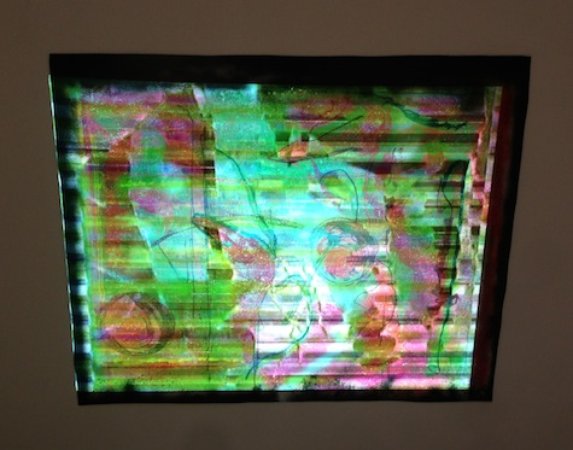
Two years ago this strange, brainy duo mesmerized critics with a show at The Kitchen that seemed to announce the birth of new hybrid art form: Dave Miko painted a series of colorful kind-of-abstractions on aluminum panels onto which Tom Thayer projected a twitchy kind-of cartoon (about the travails of a man who kills a pig and apparently goes crazy), in which the lines occasionally mapped with those in Miko's painting. This beautiful 8-minute piece, flickering away in Eleven Rivington's back room, is made in the same way but as a single, standalone composition, showing a clutch of figures reposing in an edenic landscape.
NATALIE FRANK'S WOMAN (2013) AT FREDERICKS & FREISER

Just as the artist Natalie Frank has begun to attract widespread attention for her expert paintings that collide art history, theater, and dread-inducing violence, she has deked into a new direction with her latest works, which trade her customary canvases for wooden board that she paints with enamel and then overlays with patches of cut-out canvas that she paints with oil. The result is as much collage as painting, destabilizing the viewer by adding an unexpected new dimension to the surface. (The old themes persist: note the blood-red smear on the face.)
DIANA THATER'S DAY FOR NIGHT (2013) AT DAVID ZWIRNER

"It's sort of a badge of honor among artists" never to have gone to an art fair, says the artist Diana Thater, but she broke her perfect streak this year to personally oversee the installation of her booth at David Zwirner, where four ravishing videos play. The pieces, which show bouquets of purple and blue Clematis flowers in the rain, are steeped in rich color ("one of the most important elements in my work," Thater says) and come with a complex backstory. To make the videos, the artist placed the flowers on a mirror that reflected the bright blue Los Angeles sky above and filmed them from above on a crane using a day-for-night filter—which movie directors use to make scenes shot in the day look like they occur at night—and had a rain machine pump rain between the camera and the flowers. The result, played on the most advanced video screens available, creates a tension between the "hard" cutting-edge technology used to produce the work and the "soft" beauty of the flowers in the rain, says Thater.
ALLISON MILLER'S CHIMERA (2012) AT SUSAN INGLETT GALLERY

Susan Inglett discovered Allison Miller's work in 2006 when she saw a review of her show at L.A.'s ACME Gallery in Artforum ("I actually do read reviews," the dealer says). Since then Miller has been spotted by other tastemakers—she was featured in Art + Auction's list of the "50 Next Most Collectible Artists" last year—for her lively paintings, in which she works directly and impulsively on the canvas (without a study) so the viewer can read her decision-making in the finished work. "You get to go along for the tide and be included in the process," according to Inglett, who says that this style has positioned Miller in line with a group including Mary Heilmann and other artists that has come to be called the Provisional Painters.
MELEKO MOKGOSI'S MODERN ART: THE ROOT OF AFRICAN SAVAGES (2013) AT HONOR FRASER

The most electrifying piece at the Armory Show may be this one, a ten-panel work by the 31-year-old Botswana-born artist Meleko Mokgosi, who is currently teaching at New York University. Deceptively dry at first, this suite consists of wall labels copied from the Met's current "African Art, New York, and the Avant-Garde" show—a critically acclaimed exhibition about how Alfred Stieglitz and other dealers embraced African art in the early 20th century as being raw, "savage" form of expression—that the artist systematically breaks down through structural analysis to expose the Eurocentric, Western perspective that still remains ingrained in New York's art establishment. The finished product, complete with typo corrections as well as asides, digressions, and other marginalia, is the equivalent of getting a thorough F from Roland Barthes.
ALEX HUBBARD'S K-TOWN BOOGIE (2013) AT EVA PRESSENHUBER

Beauty can sometimes be treated as old hat in the contemporary art world, but this painting by Alex Hubbard is about as fresh and invigorating as it gets. Consisting of resin and paint on multiple layers of unprimed canvas, it evinces a new materiality on Hubbard's part (c.f. Natalie Frank) but remains true to his pleasingly sleek style, which does much to sex up the whole category of abstraction.
THEASTER GATES'S TAR WITH VERTICAL FASTENERS (2012) AT KAVI GUPTA

Last year Theaster Gates held court at the Armory as the fair's commissioned artist, bringing an inner-city school room and welcome dose of social consciousness to the fair, and this year he has a has an unsurprisingly smaller footprint on the Piers—but one that shows him as a savvy object-maker as well as experience engineer. Coming from his "Tar Painting" series, this work consists of, essentially, a chunk of roof: it's a metal support covered by a layer of tar and plastic membrane, just as a professional roofer—like Gates's father, who trained the artist in the craft—would do it. An emblem of the hard labor that furnishes the means of employment for the lowest economic echelon, this piece also succeeds as a rather handsome abstract painting.
OLAFUR ELIASSON'S YOUR EMERGENCE (DARK ORANGE TO TURQUOISE) (2013) AT I8 GALLERY

At i8 Gallery, the effortlessly cool titan of the exciting Icelandic art scene, the Danish-Icelandic artist Olafur Elíasson once again proves himself to be a master of the wonders of perception with this lovely piece. And while sometimes his works can have the whiff of a science museum on them, this sculpture is pure fun. It consists of two sheets of handmade glass, tinted to replicate the fading hues of water colors, placed on a piece of driftwood that had washed up on Iceland's shores after floating away from Russia. The "drift" in driftwood is crucial here: slippage between water and glass, and optics and art, are all at play.











